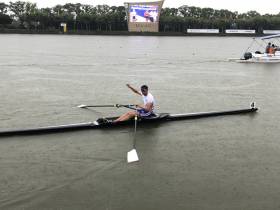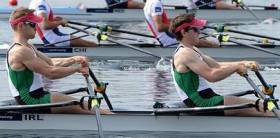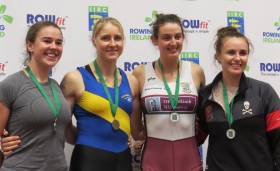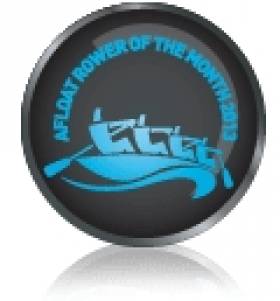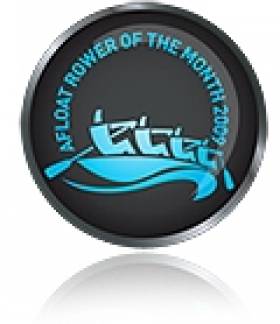Displaying items by tag: Rower of Month
#Rowing: The Afloat Rowers of the Month for April are the Enniskillen girls’ and boys’ junior 18 eights which won at Commercial and Neptune regattas, respectively. The young women won the final race at Commercial, beating the hosts in a fine contest which drew the curtain on more than two days of action at Islandbridge. Enniskillen’s boys’ junior 18 eight had beaten Coláiste Iognáid at Neptune regatta on the Saturday.
Enniskillen’s fine run recently has included outstanding placings in the Schools’ Head of the River in London, where the girls placed fourth and the boys sixth – and sixth fastest overall.
Rower of the Month awards: The judging panel is made up of Liam Gorman, rowing correspondent of The Irish Times and David O'Brien, Editor of Afloat magazine. Monthly awards for achievements during the year will appear on afloat.ie. Keep a monthly eye on progress and watch our 2019 champions list grow.
Curry is Afloat Rower of the Month for February
#Rowing: The Afloat Rower of the Month for February is Molly Curry. In a set of weeks in which action on the water was severely limited because of windy weather, the Ireland trials at the National Rowing Centre were welcome – and of high quality. World Rowing Champions Paul O’Donovan and Sanita Puspure won in fine style, while the standard of junior rowing was notable. Curry, from Coleraine Grammar School, showed good form. She was the top woman junior in the time trial and went on to compete in the same 2,000 metre race as Puspure.
Rower of the Month awards: The judging panel is made up of Liam Gorman, rowing correspondent of The Irish Times and David O'Brien, Editor of Afloat magazine. Monthly awards for achievements during the year will appear on afloat.ie. Keep a monthly eye on progress and watch our 2019 champions list grow.
O'Donovan and Puspure are Rowers of the Month
#Rowing: Sanita Puspure and Paul O’Donovan are the Rowers of the Month for January 2019.
The two world champions turned up for action at the Irish Indoor Rowing Championships at the University of Limerick – and both set new records for the event.
O’Donovan set a new mark as a lightweight of six minutes 6.2 seconds, while Puspure recorded 6:35.9. This matched her best and also set a new Irish record.
Rower of the Month awards: The judging panel is made up of Liam Gorman, rowing correspondent of The Irish Times and David O'Brien, Editor of Afloat magazine. Monthly awards for achievements during the year will appear on afloat.ie. Keep a monthly eye on progress and watch our 2019 champions list grow.
McKeown's Gold in China Brings Another Reward
#Rowing: The Rower of the Month for August is Sam McKeown. The Queen’s University, Belfast, student won gold in the single sculls final at the World University Rowing Championships in Shanghai. The Portadown man, representing Britain, came in ahead of Chinese and Finnish opponents.
It was another month when Irish rowers were prominent: a young team represented Ireland at the World Junior Championships, while Paul and Gary O’Donovan added a silver medal to their haul as they headed up the Ireland team at the European Championships.
Rower of the Month awards: The judging panel is made up of Liam Gorman, rowing correspondent of The Irish Times and David O'Brien, Editor of Afloat magazine. Monthly awards for achievements during the year will appear on afloat.ie. Keep a monthly eye on progress and watch our 2018 champions list grow.
O'Donovans Head for Lucerne as Afloat Rowers of Month
#Rowers of the Month: Paul O’Donovan and Gary O’Donovan are the Afloat rowers of the month for June. Both brothers showed outstanding form at Cork Regatta. Paul O’Donovan won the single sculls. In the heats, Gary had not been the next fastest, but come the final the elder O’Donovan brother was second only to Paul. The two raced in the double, where they were tested by Fintan and Jake McCarthy, but came through with the win.
The O’Donovans were run close by David O’Malley and Shane Mulvaney. The UCD pair were outstanding at Cork Regatta. They won the pairs title, beating world lightweight champions Shane O’Driscoll and Mark O’Donovan, and they slotted into the UCD four which also won. O’Malley and Mulvaney form the Ireland lightweight pair in a strong team for the World Under-23 Championships this month. The O’Donovans, who went on to reach the final at Henley Royal Regatta, head for the World Cup in Lucerne next weekend (July 13th to 15th). Good luck to all those competing in this busy month.
Rower of the Month awards: The judging panel is made up of Liam Gorman, rowing correspondent of The Irish Times and David O'Brien, Editor of Afloat magazine. Monthly awards for achievements during the year will appear on afloat.ie. Keep a monthly eye on progress and watch our 2018 champions list grow.
Puspure Honoured as Women Produce Good Results
#Rowing: The Afloat Rower of the Month for January is Sanita Puspure. The Old Collegians competitor produced a creditable time of six minutes 39.8 seconds for 2,000 metres at the Irish Indoor Rowing Championships. Sam McKeown beat his own time to set a new record of 5:53.0 and lead the men’s rankings, while Puspure headed up a good set of performances by women. Aileen Crowley, Emily Hegarty, Aifric Keogh and Fiona Murtagh all recorded figures under seven minutes.
Rower of the Month awards: The judging panel is made up of Liam Gorman, rowing correspondent of The Irish Times and David O'Brien, Editor of Afloat magazine. Monthly awards for achievements during the year will appear on afloat.ie. Keep an eye on progress and watch our 2018 champions list grow.
Ireland's Great Eight Pair are Rowers of the Month
Afloat Honours O'Donovan for World Cup Performance
# ROWING: Paul O’Donovan is the Afloat Rower of the Month for June. The UCD man had a remarkable start to his career as a senior international, beating former world champion Duncan Grant to win their heat of the lightweight single sculls at the World Cup regatta at Dorney Lake. He qualified for the final by taking second place in the semi-final, and while he found it difficult to find his rhythm in the final, the 19-year-old Skibbereen man had already made his mark. He will represent Ireland at the World Under-23 Championships in Linz in Austria later this month.
Rower of the Month awards: The judging panel is made up of Liam Gorman, rowing correspondent of The Irish Times and David O'Brien, Editor of Afloat magazine. Monthly awards for achievements during the year will appear on afloat.ie and the overall national award will be presented to the person or crew who, in the judges' opinion, achieved the most notable results in, or made the most significant contribution to rowing during 2013. Keep a monthly eye on progress and watch our 2013 champions list grow.
UCD Men's Senior Eight the Afloat Rowers of the Month
The Afloat Rowers of the Month for July are the UCD men’s senior eight which brought back the Big Pot to the college for the first time since 1973 at the National Rowing Championships. The big crew of Simon Craven, Peter Grogan, Colm Pierce (the club captain), David Neale, Finbar Manning, Sean Jacob, Gearoid Duane and stroke Tom Doyle were coxed by Jenny Lynch and coached by Pat McDonagh. They were clear winners over NUIG/Grainne Mhaol on the day and are worthy winners of the Afloat Rowers of the Month.
Rower of the Month awards: The judging panel is made up of Liam Gorman, rowing correspondent of The Irish Times, President of Rowing Ireland Anthony Dooley and David O'Brien, Editor of Afloat magazine. Monthly awards for achievements during the year will appear on afloat.ie and the overall national award will be presented to the person or crew who, in the judges' opinion, achieved the most notable results in, or made the most significant contribution to rowing during 2011. Keep a monthly eye on progress and watch our 2011 champions list grow.




























